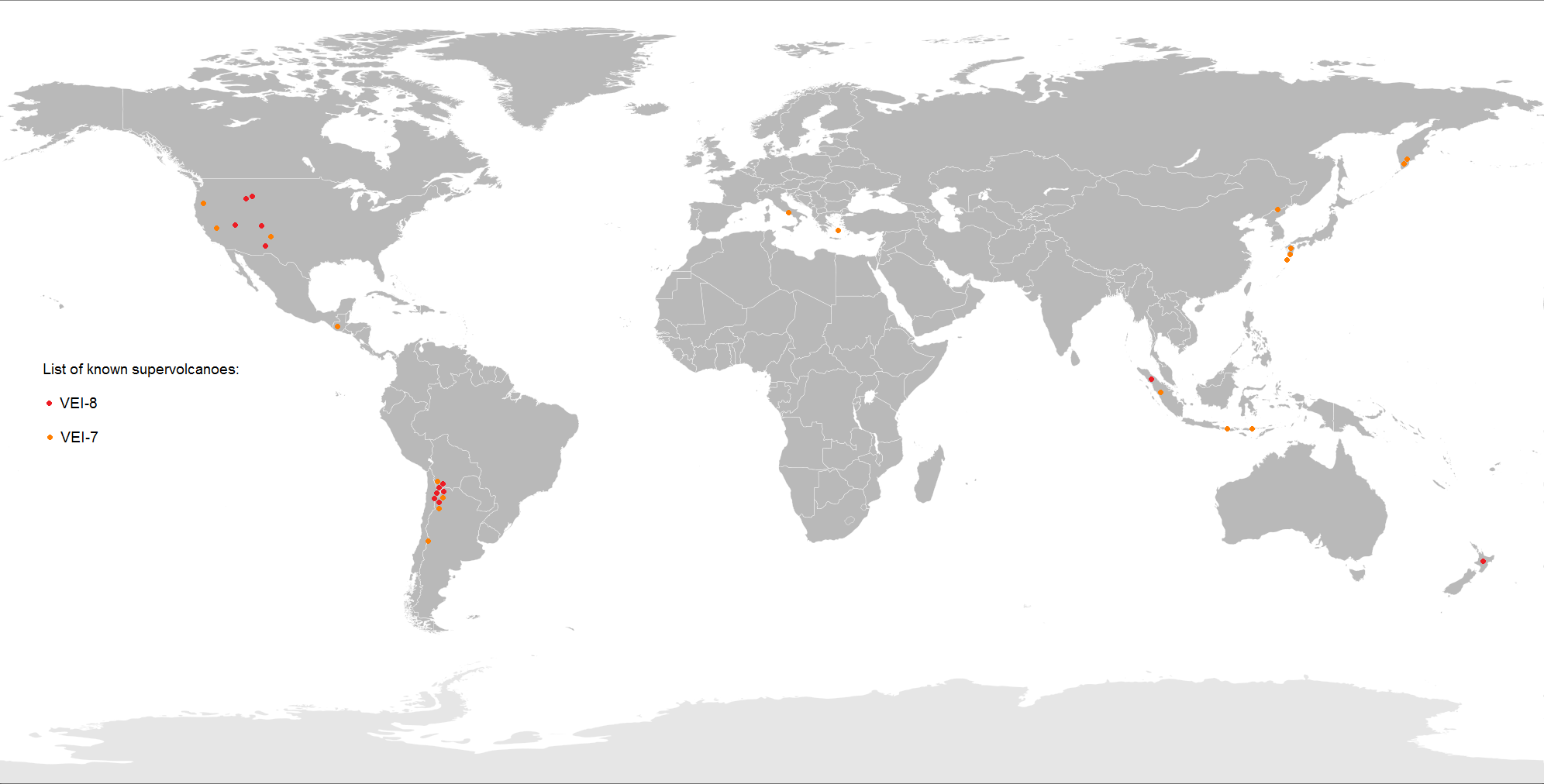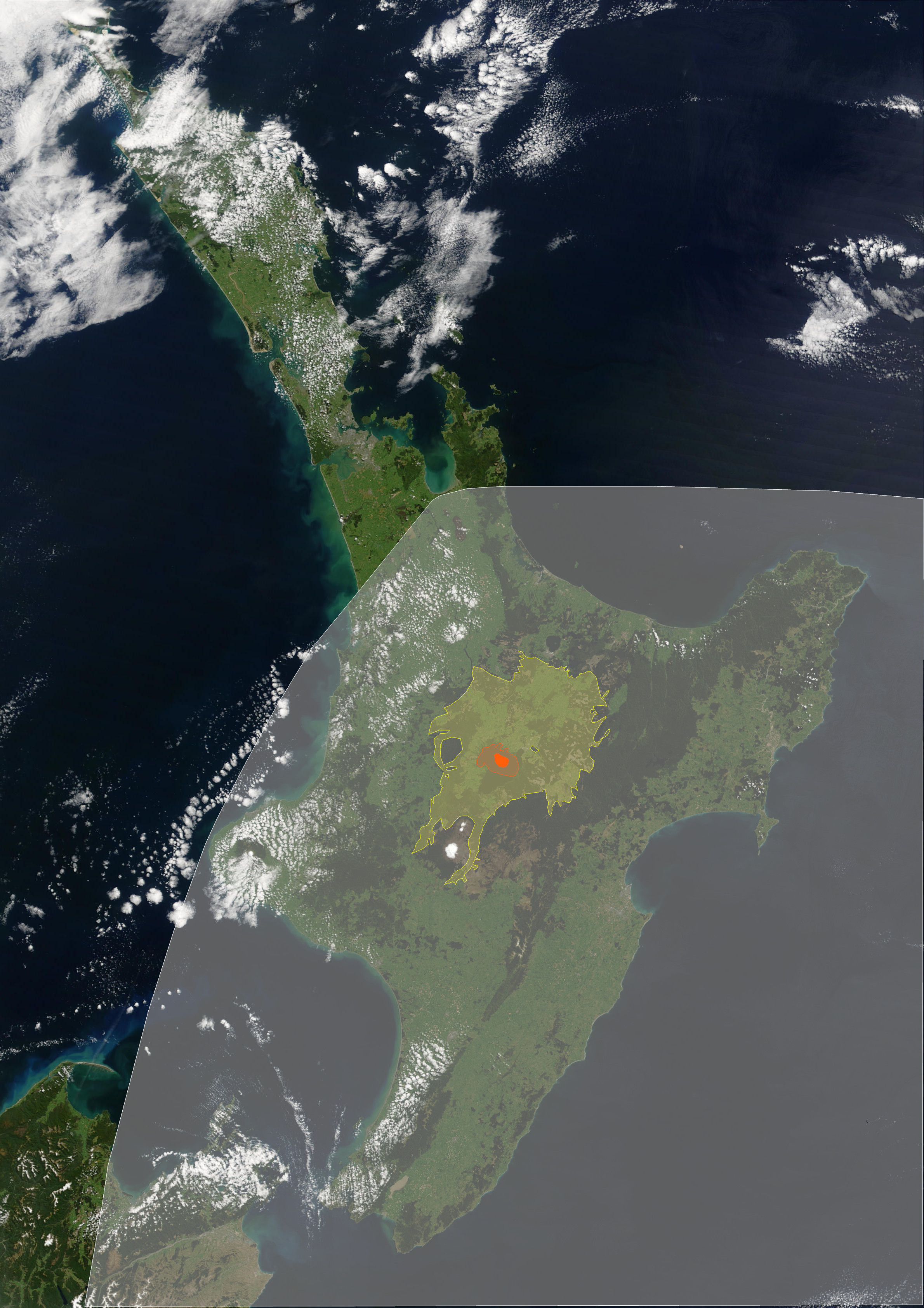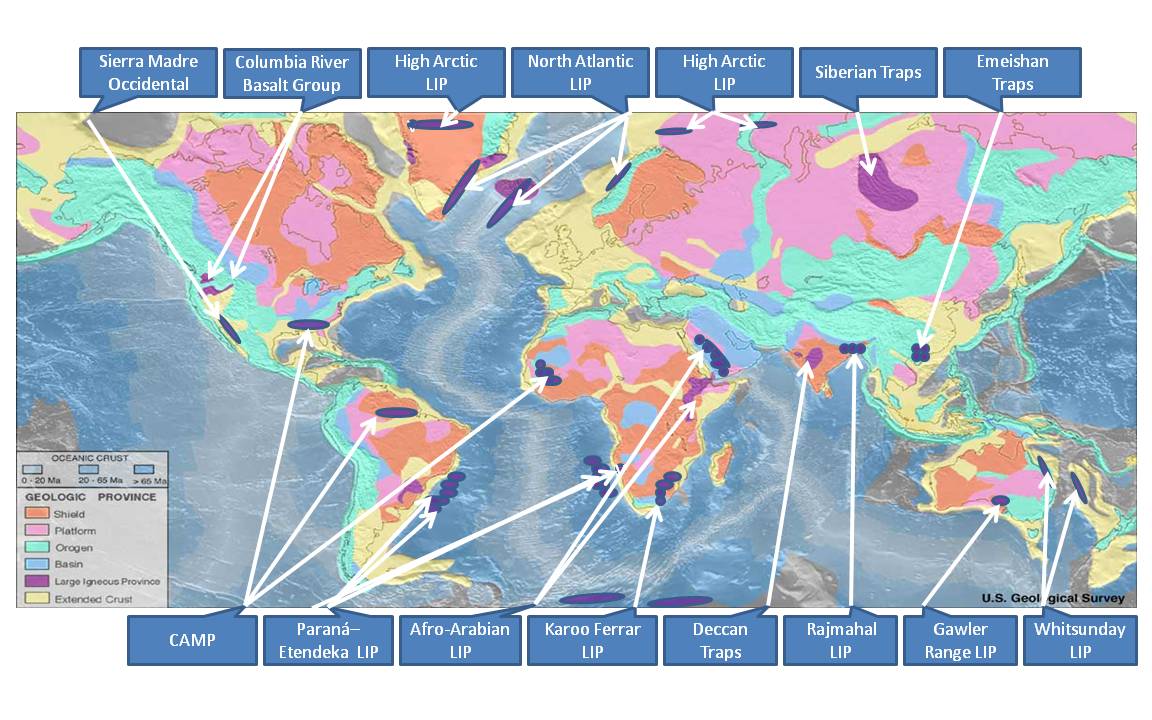|
Supervolcanoes
A supervolcano is a volcano that has had an eruption with a volcanic explosivity index (VEI) of 8, the largest recorded value on the index. This means the volume of deposits for such an eruption is greater than . Supervolcanoes occur when magma in the mantle rises into the crust but is unable to break through it. Pressure builds in a large and growing magma pool until the crust is unable to contain the pressure and ruptures. This can occur at hotspots (for example, Yellowstone Caldera) or at subduction zones (for example, Toba). Large-volume supervolcanic eruptions are also often associated with large igneous provinces, which can cover huge areas with lava and volcanic ash. These can cause long-lasting climate change (such as the triggering of a small ice age) and threaten species with extinction. The Oruanui eruption of New Zealand's Taupō Volcano (about 25,600 years ago) was the world's most recent VEI-8 eruption. Terminology The term "supervolcano" was first use ... [...More Info...] [...Related Items...] OR: [Wikipedia] [Google] [Baidu] |
Caldera
A caldera ( ) is a large cauldron-like hollow that forms shortly after the emptying of a magma chamber in a volcanic eruption. An eruption that ejects large volumes of magma over a short period of time can cause significant detriment to the structural integrity of such a chamber, greatly diminishing its capacity to support its own roof and any substrate or rock resting above. The ground surface then collapses into the emptied or partially emptied magma chamber, leaving a large depression at the surface (from one to dozens of kilometers in diameter). Although sometimes described as a Volcanic crater, crater, the feature is actually a type of sinkhole, as it is formed through subsidence and collapse rather than an explosion or impact. Compared to the thousands of volcanic eruptions that occur over the course of a century, the formation of a caldera is a rare event, occurring only a few times within a given window of 100 years. Only eight caldera-forming collapses are known to have ... [...More Info...] [...Related Items...] OR: [Wikipedia] [Google] [Baidu] |
Volcano
A volcano is commonly defined as a vent or fissure in the crust of a planetary-mass object, such as Earth, that allows hot lava, volcanic ash, and gases to escape from a magma chamber below the surface. On Earth, volcanoes are most often found where tectonic plates are diverging or converging, and because most of Earth's plate boundaries are underwater, most volcanoes are found underwater. For example, a mid-ocean ridge, such as the Mid-Atlantic Ridge, has volcanoes caused by divergent tectonic plates whereas the Pacific Ring of Fire has volcanoes caused by convergent tectonic plates. Volcanoes resulting from divergent tectonic activity are usually non-explosive whereas those resulting from convergent tectonic activity cause violent eruptions."Mid-ocean ridge tectonics, volcanism and geomorphology." Geology 26, no. 455 (2001): 458. https://macdonald.faculty.geol.ucsb.edu/papers/Macdonald%20Mid-Ocean%20Ridge%20Tectonics.pdf Volcanoes can also form where there is str ... [...More Info...] [...Related Items...] OR: [Wikipedia] [Google] [Baidu] |
Yellowstone Caldera
The Yellowstone Caldera, also known as the Yellowstone Plateau Volcanic Field, is a Quaternary caldera complex and volcanic plateau spanning parts of Wyoming, Idaho, and Montana. It is driven by the Yellowstone hotspot and is largely within Yellowstone National Park. The field comprises four overlapping calderas, multiple lava domes, resurgent domes, crater lakes, and numerous bimodal lavas and tuffs of basaltic and rhyolitic composition, originally covering about . Volcanism began 2.15 million years ago and proceeded through three major volcanic cycles. Each cycle involved a large ignimbrite eruption, continental-scale ash-fall, and caldera collapse, preceded and followed by smaller lava flows and tuffs. The first and also the largest cycle was the Huckleberry Ridge Tuff eruption about 2.08 million years ago, which formed the Island Park Caldera. The most recent supereruption, about 0.63 million years ago, produced the Lava Creek Tuff and created the present Yellowsto ... [...More Info...] [...Related Items...] OR: [Wikipedia] [Google] [Baidu] |
Oruanui Eruption
The Oruanui eruption (also known as the Kawakawa eruption or Kawakawa/Oruanui event) of Taupō Volcano in New Zealand around 25,700 years before present was the world's most recent supereruption, and its largest phreatomagmatic eruption characterised to date. Geography At the time of the eruption, the sea level was much lower than at present, and for over 100,000 years the Taupō Volcano had been mainly under Lake Huka, a larger lake than the present Lake Taupō. Lake Huka was destroyed in the eruption, and other features of the local geography were changed significantly as outlined below. Eruption With a Volcanic Explosivity Index of 8, it is one of the largest eruptions ever to occur in New Zealand and the most recent supereruption. It occurred years BP in the Late Pleistocene. It generated approximately of pyroclastic fall deposits, of pyroclastic density current (PDC) deposits (mostly ignimbrite), and of primary intracaldera material, equivalent to of rhyolitic m ... [...More Info...] [...Related Items...] OR: [Wikipedia] [Google] [Baidu] |
Ejecta
Ejecta (; ) are particles ejected from an area. In volcanology, in particular, the term refers to particles including pyroclastic rock, pyroclastic materials (tephra) that came out of a explosive eruption, volcanic explosion and magma eruption volcano, volcanic vent, or volcanic crater, crater, has traveled through the air or water, and fell back to the ground surface or seabed, ocean floor. Volcanology Typically in volcanology, ejecta is a result of explosive eruptions. In an explosive eruption, large amounts of volcanic gas, gas are dissolved in extremely viscous lava; this lava froths to the surface until the material is expelled rapidly due to the trapped pressure. Sometimes in such an event a lava plug or volcanic neck forms from lava that solidifies inside a volcano's vent, causing heat and pressure to build up to an extreme with no way to escape. When the blockage breaks and cannot sustain itself any longer, a more violent eruption occurs, which allows materials to be e ... [...More Info...] [...Related Items...] OR: [Wikipedia] [Google] [Baidu] |
Lake Toba
Lake Toba (, Toba Batak: ᯖᯀᯬ ᯖᯬᯅ; romanized: ''Tao Toba'') is a large natural lake in North Sumatra, Indonesia, occupying the caldera of the Toba supervolcano. The lake is located in the middle of the northern part of the island of Sumatra, with a surface elevation of about , the lake stretches from to . The lake is about long, wide, and up to deep. It is the largest lake in Indonesia and the largest volcanic lake in the world. Toba Caldera is one of twenty geoparks in Indonesia, and was recognised in July 2020 as one of the UNESCO Global Geoparks. Lake Toba is the site of a supervolcanic eruption estimated at VEI 8 that occurred 69,000 to 77,000 years ago, representing a climate-changing event. Recent advances in dating methods suggest a more accurate eruption date of 74,000 years ago. It is the largest-known explosive eruption on Earth in the last 25 million years. According to the Toba catastrophe theory, the eruption had global consequences for human po ... [...More Info...] [...Related Items...] OR: [Wikipedia] [Google] [Baidu] |
Large Igneous Province
A large igneous province (LIP) is an extremely large accumulation of igneous rocks, including intrusive ( sills, dikes) and extrusive (lava flows, tephra deposits), arising when magma travels through the crust towards the surface. The formation of LIPs is variously attributed to mantle plumes or to processes associated with divergent plate tectonics. The formation of some of the LIPs in the past 500 million years coincide in time with mass extinctions and rapid climatic changes, which has led to numerous hypotheses about causal relationships. LIPs are fundamentally different from any other currently active volcanoes or volcanic systems. Overview Definition In 1992, Coffin and Eldholm initially defined the term "large igneous province" as representing a variety of mafic igneous provinces with areal extent greater than 100,000 km2 that represented "massive crustal emplacements of predominantly mafic (magnesium- and iron-rich) extrusive and intrusive rock, and origin ... [...More Info...] [...Related Items...] OR: [Wikipedia] [Google] [Baidu] |
Taupō Volcano
Lake Taupō, in the centre of New Zealand's North Island, fills the caldera of the Taupō Volcano, a large rhyolitic supervolcano. This huge volcano has produced two of the world's most powerful eruptions in geologically recent times. The volcano is in the Taupō Volcanic Zone within the Taupō Rift, a region of rift volcanic activity that extends from Mount Ruapehu, Ruapehu in the south, through the Taupō District, Taupō and Rotorua Lakes, Rotorua districts, to Whakaari / White Island, in the Bay of Plenty. ImageSize = width:320 height:800 PlotArea = right:50 top:10 left:50 bottom:10 DateFormat = yyyy TimeAxis = orientation:vertical order:reverse Period = from:-10000 till:2050 AlignBars = early ScaleMajor = unit:year increment:1000 start:-10000 Colors = id:canvas value:rgb(1,1,0.85) BackgroundColors = canvas:canvas PlotData = width:15 color:white bar:test from:-10000 till:1200 # Pre Maori PlotData = width:15 color:yellow bar:test from:1200 till: ... [...More Info...] [...Related Items...] OR: [Wikipedia] [Google] [Baidu] |
Volcanic Eruption
A volcanic eruption occurs when material is expelled from a volcanic vent or fissure. Several types of volcanic eruptions have been distinguished by volcanologists. These are often named after famous volcanoes where that type of behavior has been observed. Some volcanoes may exhibit only one characteristic type of eruption during a period of activity, while others may display an entire sequence of types all in one eruptive series. There are three main types of volcanic eruptions. Magmatic eruptions involve the decompression of gas within magma that propels it forward. Phreatic eruptions are driven by the superheating of steam due to the close proximity of magma. This type exhibits no magmatic release, instead causing the granulation of existing rock. Phreatomagmatic eruptions are driven by the direct interaction of magma and water, as opposed to phreatic eruptions, where no fresh magma reaches the surface. Within these broad eruptive types are several subtypes. The we ... [...More Info...] [...Related Items...] OR: [Wikipedia] [Google] [Baidu] |
Horizon (BBC TV Series)
''Horizon'' is an ongoing and long-running British documentary television series on BBC Two that covers science and philosophy. History The programme was first broadcast on 2 May 1964 with "The World of Buckminster Fuller", which explored the theories and structures of inventor Richard Buckminster Fuller and included the ''Horizon'' mission statement: "The aim of ''Horizon'' is to provide a platform from which some of the world's greatest scientists and philosophers can communicate their curiosity, observations and reflections, and infuse into our common knowledge their changing views of the universe". ''Horizon'' continues to be broadcast on BBC Two, and in 2009 added a series of films based on the rich ''Horizon'' archive, called ''Horizon Guides'', on BBC Four. In December 2016, it was announced that ''Horizon'' would no longer be made exclusively by the BBC's in-house production division, BBC Studios, and the BBC invited independent production companies to pitch to make epi ... [...More Info...] [...Related Items...] OR: [Wikipedia] [Google] [Baidu] |
Howel Williams
Howel Williams (October 12, 1898 – January 12, 1980) was an American geologist and volcanologist. Early life He was born of Welsh parents in Liverpool, England, on October 12, 1898. He received a BA in geography in 1923 and an MA in archaeology in 1924 from Liverpool University. He studied geology at the Imperial College of Science and Technology in London. Howel Williams moved to the University of California at Berkeley in 1926. In 1928 he was awarded the degree of D.Sc. from the University of Liverpool and published his first papers on the geology of various California volcanic regions. Williams was a member of the National Academy of Sciences. Career He published many studies on the volcanoes of California, but is most noted for his "The Geology of Crater Lake National Park" in which he recognized the nature of the collapse of the crater and extended the work to develop the principles of volcanic caldera formation. He did extensive early work on the geology of Central ... [...More Info...] [...Related Items...] OR: [Wikipedia] [Google] [Baidu] |








